Absolute monarchy in France
Last updatedThis article needs additional citations for verification .(January 2020) |
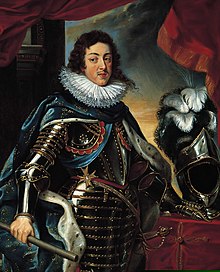
Absolute monarchy in France slowly emerged in the 16th century and became firmly established during the 17th century. Absolute monarchy is a variation of the governmental form of monarchy in which the monarch holds supreme authority and where that authority is not restricted by any written laws, legislature, or customs. In France, Louis XIV was the most famous exemplar of absolute monarchy, with his court central to French political and cultural life during his reign. It ended in May 1789, when widespread social distress led to the convocation of the Estates-General, which was converted into a National Assembly in June. The Assembly passed a series of radical measures, including the abolition of feudalism, state control of the Catholic Church and extending the right to vote.
Contents
Introduction
The 16th century was strongly influenced by religious conflicts [1] that developed out of the Reformation. France's precarious position created ideal conditions for the formation and justification of absolute monarchy. Its disputes between monarchy and community as well as the fatal loss of the House of Valois' [2] authority during the second half of the 16th century prompted theoretical reflections that led to the consolidation of the monarchy's power.
Establishment
By the early 9th century, the efficient administration of Charlemagne's Empire was ensured by high-level civil servants, carrying the, then non-hereditary, titles of counts (in charge of a County), marquis (in charge of a March), dukes (military commanders), etc. During the course of the 9th and 10th centuries, continually threatened by Viking invasions, France became a very decentralised state: the nobility's titles and lands became hereditary, and the authority of the king became more religious than secular and thus was less effective and constantly challenged by powerful noblemen. Thus was established feudalism in France. Over time, some of the king's vassals would grow so powerful that they often posed a threat to the king.
Since then, French kings had continuously tried to strengthen existing royal powers scattered among their nobles. Philip the Fair, Charles the Wise and Louis the Cunning were instrumental in the transformation of France from a feudal state to a modern country. By the time of Francis I, France was a very centralized state but the French Wars of Religion posed a new threat to royal absolutism with quasi-independent Protestant strongholds developing in various locations in the country.
With his skillful Prime Minister Richelieu, who vowed "to make the royal power supreme in France and France supreme in Europe." (source: Cardinal Richelieu's Political Testament), Louis XIII established Absolute Monarchy in France during his reign. When his son and successor Louis XIV came to power, a period of trouble known as the Fronde occurred in France, taking advantage of Louis XIV's minority. This rebellion was driven by the great feudal lords and sovereign courts as a reaction to the rise of royal power in France.
The rebellion was crushed; however, many obstacles stood in the way of absolutism in France:
- Nobles had the means to raise private armies and build fortifications. The king did not have the means to raise and keep an army himself and had to rely on these nobles to defend the nation;
- Lesser nobles, who had the ability to read and write, also acted as the king's agents. Effectively, they were his representatives of government to the people. They collected taxes, posted edicts, and administered justice.
- The Huguenots, who since the 1598 Edict of Nantes by Henry IV, held the rights to bear arms and to build fortifications in certain locations.
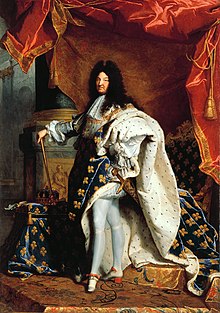
To overcome these obstacles King Louis XIV adopted several measures to weaken or eliminate competing centers of power:
The Edict of Fontainebleau in 1685 removed the former policy of tolerance toward French Huguenots, as formalised by the Edict of Nantes
A more subtle tactic was the demolition of a number of fortified castles still owned and occupied by members of the nobility. This Edict of 1626 was justified as a budgetary reform to reduce maintenance costs by removing obsolete fortifications within the borders of France. While a rational economic step in itself, this measure did have the additional effect of undermining the independence of the aristocracy.
Louis XIV reduced the nobles' power further by requiring them to spend at least some portion of the year as courtiers in residence at the Palace of Versailles. At Versailles, the aristocracy were removed from their provincial power centers and came under the surveillance and control of the royal government. Rather than seen as demeaning, the nobles took required membership of the royal court to be a high honor. Nobles, being granted residence at Versailles, were generally prepared to give up their former duties as royal representatives outside Paris. Louis XIV, with the help of his minister of finance, Jean-Baptiste Colbert, replaced them with royal appointees drawn largely from the merchant class, who were generally better educated and whose titles were revocable and not hereditary.
Limits to power
The absolute monarchy was not the same as totalitarian dictatorship, and there were limits to the king's power. Known as the "fundamental laws of the Kingdom", these evolved over time and were a set of unwritten principles which placed limits on the otherwise absolute power of the king from the Middle Ages until the French Revolution in 1789. They were based on customary usage and religious beliefs about the roles of God, monarch, and subjects. [3]
Consequences
This section has multiple issues. Please help improve it or discuss these issues on the talk page . (Learn how and when to remove these template messages)
|
The final outcome of these acts did centralize the authority of France behind the king. The replacement of government ministers, removal of castles, and other financial policies of Colbert did reduce French national debt considerably.
In the 18th century, however, the relocation of nobles and the sheer obsolescence of Versailles became an important place for a rising merchant class and an instigative press.
Perhaps the most pressing consequence of absolutism in France is the emigration of the Huguenots. Of the merchant class, their emigration effectively led to a brain drain and a loss of tax revenue for France. Moreover, barred from New France, they immigrated to other nations, most notably the Thirteen Colonies, taking their skills of printing, glass making, carpentry, ceramics, a deep belief in the needs for freedom of religion (at least for Protestantism), and the right to bear arms.
The other consequence was a large reduction of the dominating influence of the Kingdom of France in Europe, and a rise in the power of other kingdoms to strengthen their empire, notably in Great Britain, Spain, and the Holy Roman Empire. This caused numerous deadly wars with them (in Europe, America and Africa), some of them won by France or its allies (notably for the independence of the United States), but this caused the loss of most parts of New France (most continental parts in North America, including those that would be sold later to the United States after the end of monarchy in France by the First French Empire, and some islands in the Caribbean), severe degradation of the economic advantage of the first French colonial Empire, accumulation of debts in the kingdom (with a growing influence of the merchants against the French nobility), and a considerable loss of economic, diplomatic, political and cultural influence in Europe, all these being left to the growing British colonial empire (even after its loss of New England) and to its allies all around France in Spain (including the Spanish Netherlands), Austria (including Italy), Nordic countries (and later the United States).
Another consequence of the creation of the United States and of the costly wars between France and all its neighbours in Europe, was also that it initiated lot of severe political and social troubles throughout the kingdom, and it paved the way to the French Revolution and finally the end of the absolute monarchy, via a short step of constitutional monarchy (restoring some parliamentary powers to the Estates General) between 1789 and 1791, and then to the First French Republic (during which the eviction of the traditional French clergy and nobility from the new Constitution further strengthened the military alliance of all European neighbours against France). That lost influence of France was never restored in the following centuries, even after the emergence of the First French Empire (which terminated the dictature, reunited a strongly divided France, restored the freedom of religion, and allowed the reemergence of a stable commercial sector, but also initiated new wars against other monarchies in continental Europe), or after the formation of a new French colonial empire by the Third Republic.
Even today's Fifth Republic in France mimics some models from other European constitutional monarchies, because of the stability and influence of the head of state (monarch or elected president) to preserve the territorial unity by an enforced balance of powers. Unlike past republics, it even accepts and protects constitutionally the presence of nobility, religions or diverse cultures, as plain components and (non absolute) actors of the republic, even if it promotes its own unified system, freely accessible to all its nationals or applicable directly only to its foreign residents.
See also
Related Research Articles

Louis XIV, also known as Louis the Great or the Sun King, was King of France from 1643 until his death in 1715. His verified reign of 72 years and 110 days is the longest of any sovereign. Although Louis XIV's France was emblematic of the Age of Absolutism in Europe, the King surrounded himself with a variety of significant political, military, and cultural figures, such as Bossuet, Colbert, Louvois, Le Brun, Le Nôtre, Lully, Mazarin, Molière, Racine, Turenne, Condé, and Vauban.
A monarch is a head of state for life or until abdication, and therefore the head of state of a monarchy. A monarch may exercise the highest authority and power in the state, or others may wield that power on behalf of the monarch. Usually a monarch either personally inherits the lawful right to exercise the state's sovereign rights or is selected by an established process from a family or cohort eligible to provide the nation's monarch. Alternatively, an individual may proclaim themself monarch, which may be backed and legitimated through acclamation, right of conquest or a combination of means.
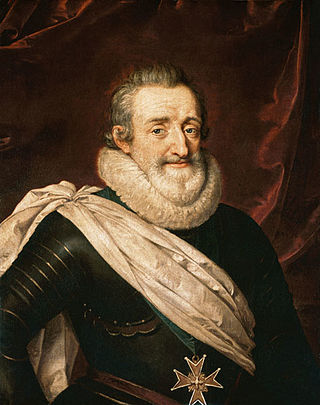
The Edict of Nantes was signed in April 1598 by King Henry IV and granted the minority Calvinist Protestants of France, also known as Huguenots, substantial rights in the nation, which was predominantly Catholic.
Absolute monarchy is a form of monarchy in which the monarch rules in his or her own right or power. In an absolute monarchy, the king or queen is by no means limited and has absolute power. These are often hereditary monarchies. On the other hand, in constitutional monarchies, in which the authority of the head of state is also bound or restricted by the constitution, a legislature, or unwritten customs, the king or queen is not the only one to decide, and his or her entourage also exercises power, mainly the prime minister.

Louis XIII was King of France from 1610 until his death in 1643 and King of Navarre from 1610 to 1620, when the crown of Navarre was merged with the French crown.

Christian V was King of Denmark and Norway from 1670 until his death in 1699.
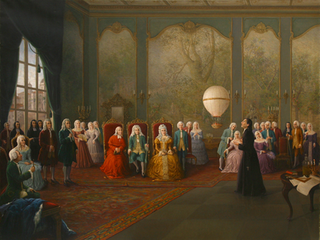
A royal court, often called simply a court when the royal context is clear, is an extended royal household in a monarchy, including all those who regularly attend on a monarch, or another central figure. Hence, the word court may also be applied to the coterie of a senior member of the nobility. Royal courts may have their seat in a designated place, several specific places, or be a mobile, itinerant court.

The Edict of Fontainebleau was an edict issued by French King Louis XIV and is also known as the Revocation of the Edict of Nantes. The Edict of Nantes (1598) had granted Huguenots the right to practice their religion without state persecution. Protestants had lost their independence in places of refuge under Cardinal Richelieu on account of their supposed insubordination, but they continued to live in comparative security and political contentment. From the outset, religious toleration in France had been a royal, rather than popular, policy.
There is significant disagreement among historians of the French Revolution as to its causes. Usually, they acknowledge the presence of several interlinked factors, but vary in the weight they attribute to each one. These factors include cultural changes, normally associated with the Enlightenment; social change and financial and economic difficulties; and the political actions of the involved parties. For centuries, the French society was divided into three estates or orders.

During the sixteenth and seventeenth centuries, politiques were Western European statesmen who prioritized the strength of the state above all other organs of society, including religion. During the French Wars of Religion, this included moderates of both religious faiths who held that the country could only be saved by the restoration of a strong monarchy which rose above religious differences. The term politique often had a pejorative connotation of moral or religious indifference, especially after 1568 in contrast with the radical Catholic League calling for the eradication of Protestantism in France. By 1588 the politiques were seen by pious detractors as a faction more pernicious than heretics.

Under the French Ancien Régime, a parlement was a provincial appellate court of the Kingdom of France. In 1789, France had 13 parlements, the oldest and most important of which was the Parlement of Paris. While both the modern French term parlement and the English word parliament derive from this French term, the Ancien Régime parlements were not legislative bodies and the modern and ancient terminology are not interchangeable.

The Estates General of 1789(French: États Généraux de 1789) was a general assembly representing the French estates of the realm: the clergy, the nobility, and the commoners. It was the last of the Estates General of the Kingdom of France.

The Kingdom of France in the early modern period, from the Renaissance to the Revolution (1789–1804), was a monarchy ruled by the House of Bourbon. This corresponds to the so-called Ancien Régime. The territory of France during this period increased until it included essentially the extent of the modern country, and it also included the territories of the first French colonial empire overseas.

The French nobility was a privileged social class in France from the Middle Ages until its abolition on 23 June 1790 during the French Revolution.

The Kingdom of France is the historiographical name or umbrella term given to various political entities of France in the medieval and early modern period. It was one of the most powerful states in Europe since the High Middle Ages. It was also an early colonial power, with colonies in Asia and Africa, and the largest being New France in North America.
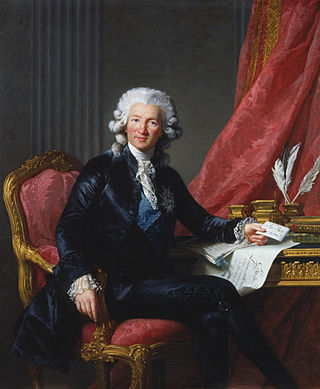
Under the Ancien Régime of France, the Nobles of the Robe or Nobles of the Gown were French aristocrats whose rank came from holding certain judicial or administrative posts. As a rule, the positions did not of themselves give the holder a title of nobility, such as baron or viscount, but they were almost always attached to a specific function. The offices were often hereditary, and by 1789, most of the holders had inherited their positions. The most influential of them were the 1,100 members of the 13 parlements, or courts of appeal.

The Ancien Régime, also known as the Old Regime, was the political and social system of the Kingdom of France from the Late Middle Ages until 1789 and the French Revolution, which abolished the feudal system of the French nobility (1790) and hereditary monarchy (1792). The Valois Dynasty ruled during the Ancien Régime up until 1589 and was subsequently replaced by the Bourbon dynasty. The term is occasionally used to refer to the similar feudal systems of the time elsewhere in Europe such as that of Switzerland.

Absolutism or the Age of Absolutism is a historiographical term used to describe a form of monarchical power that is unrestrained by all other institutions, such as churches, legislatures, or social elites. Absolutism is typically used in conjunction with some European monarchs during the transition from feudalism to capitalism, and monarchs described as absolute can especially be found in the 16th century through the 19th century. Absolutism is characterized by the ending of feudal partitioning, consolidation of power with the monarch, rise of state power, unification of the state laws, and a decrease in the influence of the church and the nobility.

The Huguenot rebellions, sometimes called the Rohan Wars after the Huguenot leader Henri de Rohan, were a series of rebellions of the 1620s in which French Calvinist Protestants (Huguenots), mainly located in southwestern France, revolted against royal authority. The uprising occurred a decade after the death of Henry IV who, himself originally a Huguenot before converting to Catholicism, had protected Protestants through the Edict of Nantes. His successor Louis XIII, under the regency of his Italian Catholic mother Marie de' Medici, became more intolerant of Protestantism. The Huguenots tried to respond by defending themselves, establishing independent political and military structures, establishing diplomatic contacts with foreign powers, and openly revolting against central power. The Huguenot rebellions came after two decades of internal peace under Henry IV, following the intermittent French Wars of Religion of 1562–1598.

The fundamental laws of the Kingdom of France were a set of unwritten principles which dealt with determining the question of royal succession, and placed limits on the otherwise absolute power of the king from the Middle Ages until the French Revolution in 1789. They were based on customary usage and religious beliefs about the roles of God, monarch, and subjects.
References
- ↑ "Sixteenth Century". Lepg.org. Retrieved 2012-10-19.
- ↑ "France History, The Valois Dynasty 1358-1589". Bonjourlafrance.com. Archived from the original on 2015-09-23. Retrieved 2012-10-19.
- ↑ Dignat, Alban (27 May 2021). Grégor, Isabelle (ed.). "XVIIe siècle : Absolutisme et monarchie en France" [17th century: Absolutism and Monarchy in France]. Herodote.net (in French). Herodote.net SAS. Retrieved 6 July 2023.
Text is available under the CC BY-SA 4.0 license; additional terms may apply.
Images, videos and audio are available under their respective licenses.